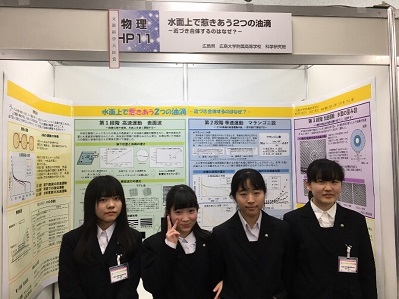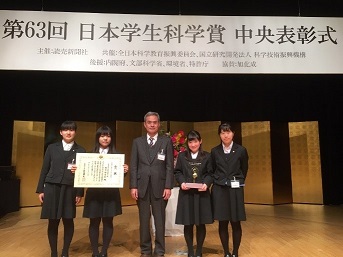広島大学附属高等学校
TEL: 082-251-0192
2019年12月22日~24日、第63回日本学生科学賞中央審査・表彰式(読売新聞社主催、旭化成協賛)が日本科学未来館で行われました。広島大学附属高等学校から、科学研究班に所属する1グループ(生徒6人)が高校2年の4月から1年半ほど取り組んだ研究「水面上で惹きあう2つの油滴-近づき合体するのはなぜ?-」が中央審査に残り、ポスターセッションなどの審査の結果、文部科学大臣賞を受賞しました。今回得られた成果は、本校がスーパーサイエンスハイスクール(SSH)指定校として全校を挙げて取り組んでいる課題研究へエールを送ることになるでしょう。


研究概要
私たちは、水面上で2滴の油滴が移動する現象について調べる機会を得ました。水の入ったシャーレに2滴の油滴を滴下し、その動きを観察した結果、滴下した2滴の油滴は必ずシャーレの中心に向かって運動して合体することが分かりました。そこで、水量・水温といった条件を変えて、より詳細な実験を行った結果、異なる条件であっても、(1) 滴下直後の高速運動、(2) 等速での接近運動、(3) 合体直前の加速運動 という共通した油滴の運動が見られました。先行研究や予備実験、観察の結果を参考に、新たな仮説を設定し、表面波の観察方法を考案、検証したところ、(1) は表面波、(2) はマランゴニ対流、(3) は水面の歪み が原因であるという3段階運動説で説明できることが分かりました。
On water surface, oil droplets gather and merge. We explored the mechanism of the oil motion when there are two oil droplets on the water surface in a petri dish. We found oil droplets show the common motion before merging even under different conditions. (1) Fast speed motion right after dropping the oil droplets, (2) Constant speed motion, (3) Accelerated motion right before merging. We examined the causes of these motions. Our conclusion is that (1) is caused by water surface waves due to dropping the droplets, (2) by the Marangoni convection and (3) by distortion of water surface. This theory about the oil motion makes an impact on our basic understanding of how objects moves on water surface.



 Home
Home
